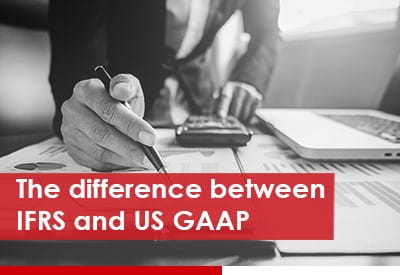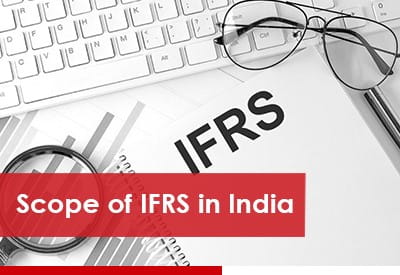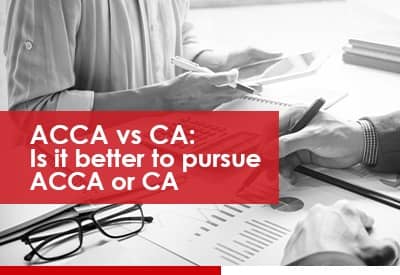
Exploring Lucrative Job Opportunities after Doing ACCA
July 6, 2023
The Scope of IFRS in India
July 27, 2023In the absence of standardized accounting principles, companies would have the freedom to manipulate their financial outcomes to present a rosier image of their success. This would significantly complicate the task of comparing the performance of different businesses.
This is where the significance of Generally Accepted Accounting Principles (GAAP) and International Financial Reporting Standards (IFRS) becomes evident. These two frameworks, one tailored to the American context and the other with a global focus, serve as the cornerstone for the majority of companies when they compile their financial statements. By adhering to these universally recognized accounting standards, individuals can have confidence that businesses are providing accurate financial disclosures. As a result, they are empowered to make well-informed choices regarding their investment endeavors.
GAAP vs. IFRS: An Overview
Financial reporting practices diverge across nations due to distinct standards. In the United States, the Financial Accounting Standards Board (FASB) establishes these practices within the framework of generally accepted accounting principles (GAAP). GAAP denotes a universally accepted collection of accounting principles, benchmarks, and protocols that corporations and accountants must adhere to while preparing their financial statements.
On the global stage, International Financial Reporting Standards (IFRS) come into play. These are a set of worldwide accounting standards that define how specific transactions and other occurrences ought to be presented in financial statements. Issued by the International Accounting Standards Board (IASB), IFRS meticulously outline the methods accountants should use to record and disclose their financial information. IFRS was formulated to establish a universal accounting language, thereby ensuring that business and financial information remains comprehensible across companies and countries.
Here are 10 differences between IFRS vs US GAAP
- Conceptual Framework:
IFRS is guided by a principles-based approach, which emphasizes conceptual frameworks, general principles, and underlying objectives. The conceptual framework of IFRS focuses on providing relevant and reliable information to users for decision-making. The framework does not prescribe specific rules for all scenarios, allowing entities to exercise judgment in their financial reporting.
In contrast, US GAAP is a rules-based approach, with extensive detailed rules and specific guidance for various accounting issues. It is heavily influenced by industry-specific practices and case law. While the FASB has been working on developing a conceptual framework, US GAAP is still considered more rules driven than IFRS.
- Financial Statement Presentation:
Under IFRS, the presentation of financial statements follows a two-statement approach: the statement of financial position (balance sheet) and the statement of comprehensive income. IFRS permits presenting items as either “current” or “non-current” on the face of the balance sheet, providing flexibility to companies.
US GAAP follows a three-statement approach: the balance sheet, the income statement, and the statement of cash flows. Additionally, US GAAP requires the classification of assets and liabilities into “current” and “non-current” on the balance sheet, providing more prescriptive guidance compared to IFRS.
- Revenue Recognition:
IFRS has adopted a principles-based standard, IFRS 15, which provides a five-step model for revenue recognition. The key principles include identifying the contract with the customer, identifying performance obligations, determining the transaction price, allocating the transaction price to the performance obligations, and recognizing revenue when performance obligations are satisfied.
US GAAP follows a more rules-based approach to revenue recognition, with specific industry-specific guidance. The guidance for revenue recognition is found in multiple standards, such as ASC 606 (for revenue recognition from contracts with customers) and various industry-specific guidance for sectors like software, real estate, and construction.
- Inventory Accounting:
Under IFRS, the standard IAS 2 governs inventory accounting. It allows both the FIFO (First-In, First-Out) and the weighted average cost methods for valuing inventory. The lower of cost and net realizable value (LCNRV) rule is applied for inventory impairment.
US GAAP allows multiple inventory valuation methods, including FIFO, LIFO (Last-In, First-Out), and average cost. However, LIFO is a widely used method in the US, which is not allowed under IFRS. US GAAP also follows a lower of cost or market (LCM) rule for inventory impairment.
Read More: Scope of IFRS
- Leases:
IFRS 16 is the current standard governing lease accounting under IFRS. It requires lessees to recognize most leases on their balance sheets, treating them as “right-of-use” assets and corresponding lease liabilities.
US GAAP lease accounting is governed by ASC 842. Similar to IFRS 16, it requires lessees to recognize lease assets and liabilities for most leases, but it retains the distinction between finance leases and operating leases for the lessor.
- Financial Instruments:
IFRS 9 is the standard for financial instruments under IFRS. It requires entities to classify financial assets into three categories: amortized cost, fair value through other comprehensive income (FVOCI), and fair value through profit or loss (FVTPL). The classification depends on the business model and contractual cash flow characteristics of the financial assets.
US GAAP’s financial instruments standard is primarily covered by ASC 825 and ASC 320. It categorizes financial assets into three groups: held-to-maturity, available-for-sale, and trading. The classification depends on the intent of the entity and the ability to hold the asset to maturity.
- Development Costs:
IFRS has a broad standard, IAS 38, that governs intangible assets. Development costs can be capitalized under IFRS if certain criteria are met, such as technical feasibility, intent to complete the asset, ability to use or sell the asset, and generation of future economic benefits.
US GAAP, specifically ASC 985-20, provides guidance on accounting for software development costs. Under US GAAP, development costs are generally expensed as incurred, except for certain software development costs that meet specific criteria for capitalization.
- Consolidation of Subsidiaries:
IFRS 10 is the standard for consolidation under IFRS. It adopts a control-based approach, requiring an entity to consolidate its subsidiaries if it has control over the investee. Control is presumed to exist when the entity holds more than 50% of the voting rights or has the power to govern the financial and operating policies.
US GAAP follows a similar approach to consolidation, but it has specific guidance under ASC 810 (formerly known as FIN 46(R)) for variable interest entities (VIEs). US GAAP’s consolidation model also places more emphasis on the assessment of variable interests and the ability to exercise control.
- Income Taxes:
Under IFRS, income tax accounting is covered by IAS 12. IFRS requires the recognition of deferred tax assets and liabilities based on temporary differences between the carrying amounts of assets and liabilities for financial reporting purposes and their tax bases.
US GAAP, covered by ASC 740, also requires the recognition of deferred tax assets and liabilities. However, there are differences in certain areas, such as intra-period tax allocation and the recognition of a valuation allowance against deferred tax assets.
- Government Grants:
IFRS has specific guidance under IAS 20 for accounting for government grants. It requires entities to recognize government grants in their financial statements when there is reasonable assurance that the grant will be received, and the entity will comply with the conditions attached to it.
US GAAP does not have specific guidance on government grants. Entities account for government grants by considering the specific facts and circumstances of the grant and applying relevant accounting standards related to revenue recognition or other applicable guidance.
Read More: How to Study and pass IFRS Exam
Conclusion
IFRS and US GAAP are two distinct accounting frameworks, each with its own advantages and disadvantages. IFRS is principles-based, providing flexibility, and allowing for more judgment in financial reporting. On the other hand, US GAAP is rules-based, offering specific guidance for various accounting issues. Companies operating globally or planning to list their shares in international stock exchanges must be aware of the differences between IFRS and US GAAP and be prepared to adapt their financial reporting practices accordingly. It is essential to stay updated with the latest changes and developments in both frameworks to ensure compliance and accurate financial reporting.




